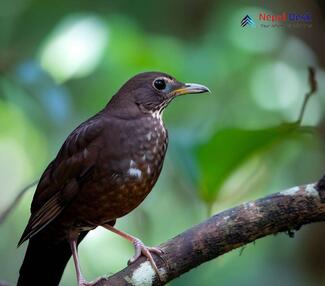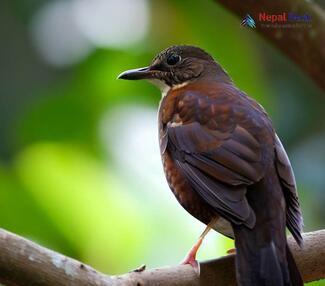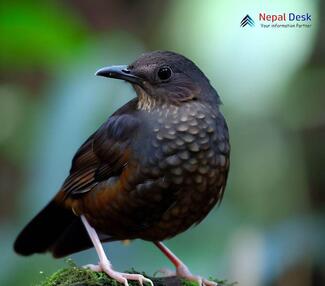Nepal is a dream come true for bird lovers, thanks to its amazing variety of bird species. Among the many birds that thrive there, the Dark-sided Thrush (Zoothera marginata) is one of them. This unique bird, which belongs to the thrush family Turdidae, goes by several other names including the lesser brown thrush, the long-billed ground thrush, and the dark-sided ground thrush. The Dark-sided Thrush doesn't have any subspecies and is closely related to some of its Zoothera cousins such as the long-billed thrush and the commonly found scaly thrush. Edward Blyth first described this bird back in 1847 after discovering it in Rakhine, Burma (now Myanmar).
Let us look at the various aspects of this bird:
Discovering the Dark-sided Thrush
The Dark-sided Thrush is a medium-sized passerine bird belonging to the Turdidae family. These birds exhibit a slate-grey to brownish-grey plumage with a pale underside. What sets them apart is the distinctive olive-brown patch on their wings and dark barring on their chest and flanks. They have robust legs and feet that allow them to intricately navigate the forest floor as they search for food.
Distribution and Habitat
This captivating avian species call the dense forests and well-wooded areas in Nepal its home. However, they are not limited to this region alone; their distribution extends from eastern Afghanistan through parts of India, Bhutan, China, Thailand, Myanmar, and Vietnam. Found at elevations ranging from 2,000 to 4,300 meters above sea level in their breeding season (June to August), they prefer undisturbed habitats covered with mosses, ferns, and an abundance of leaf litter.
Dietary Habits
The diet of the Dark-sided Thrush mainly consists of insects such as beetles, caterpillars, ants, and spiders. While foraging for food on the forest floor using their long bills, they unveil insects concealed beneath leaves or within bark crevices. Occasionally supplementing their diet with berries or fruits make them opportunistic omnivores.
Breeding Behavior
The breeding season of the Dark-sided Thrush commences in June and lasts until August, during which time they are most frequently encountered. The female lays her eggs in a well-hidden, carefully constructed cup-shaped nest made from grass, moss, and other various vegetation on the forest floor or ledges. Both males and females share incubation duties as well as protecting their territory with high-pitched vocal calls and frequent warning songs.
Conservation status
Although the exact population numbers of the Dark-sided Thrush are not clear, it is believed to have a wide range of distribution across its habitat range. However, conservationists maintain that logging activities and habitat degradation pose considerable threats to their survival. Continued monitoring programs and research are essential for better understanding this elusive bird species' conservation requirements.
In Conclusion, the enigmatic Dark-sided Thrush of Nepal offers an intriguing glimpse into the rich biodiversity found in this beautiful nation. Its majestic presence reminds us of the importance of conserving our natural habitats filled with these intriguing avian marvels. So keep your eyes and ears open to the captivating world of Nepal's birdlife and experience the wonder of discovering the elusive Dark-sided Thrush for yourself.




